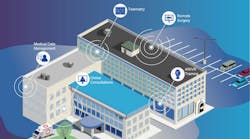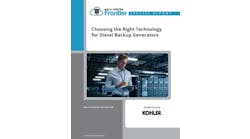In this week’s Voices of the Industry, Bruno Berti, Director Product Management at RagingWire Data Centers, shares why interconnection matters to wholesale colocation.
Bruno Berti, Director Product Management, at RagingWire Data Centers
Providing large scale, secure space and power has been the focus of wholesale data center providers for many years. Until recently, innovation in wholesale data center solutions has centered on developing data center designs that improve power resiliency and building efficiency. The result being that wholesale customers today are receiving data centers that are more flexible, scalable, and cost effective than ever before.
The cloud and surge in wholesale data center demand are changing the industry, but not in the way that many expected. Interconnection between wholesale data centers and public cloud environments is becoming a key decision criteria rather than an afterthought or “nice-to-have”. Interconnection has become a major component of the wholesale data center colocation strategy.
The Hybrid-Cloud Changes Everything.
The demand for interconnection is being driven by the changing market dynamics, specifically in hybrid cloud. Over the past five years, enterprise organizations have been successfully adopting the public cloud as a complement to rather than as a replacement for their enterprise or colocation environments. The term “hybrid cloud,” came from the desire for enterprises to utilize a combination of clouds, in-house data centers, and external colocation facilities to support their IT environments.
The challenge with having a hybrid environment arises from the need for the data centers and the cloud providers to interconnect and share data securely and with low network latency as part of one extended environment. Within a data center, servers and storage can be directly connected. A hybrid cloud environment doesn’t have the luxury of short distances, so bring on the innovation.
[clickToTweet tweet=”Bruno Berti – Interconnection has become a major component of the wholesale data center colocation strategy. ” quote=”Bruno Berti – Interconnection has become a major component of the wholesale data center colocation strategy.”]
From Carriers to Interconnection
The first interconnection solutions were provided by telecommunications service providers. Dark fiber, lit fiber, and Internet access were all leveraged to interconnect hybrid cloud environments. However, as cloud deployments grew and matured, these network solutions became difficult to secure and manage.
Next, data center providers began to offer “direct” connections within the data center to bring cloud and colocation environments into one location, allowing interconnections to be provided through fiber cross-connects. This approach, however, restricts the choices where companies can place their colocation environments and limits the types of cloud environments to which they can connect.
The newest solutions are being introduced by interconnection platform providers, which leverage the concepts of network exchange points and software defined networking (SDN) to provide a flexible solution that can be self-managed. These innovative solutions solve many the key network challenges introduced by hybrid clouds.
The Keys to Interconnection – Dedicated, secured, and many-to-many
Beyond the simple one-to-one interconnection of a cloud environment to a wholesale colocation environment, an interconnection platform is designed to allow many-to-many connections in a dedicated and secured fashion. With an interconnection platform, wholesale colocation environments can be connected to multiple cloud providers (multi-cloud) and multiple cloud locations (availability zones). This design opens the door to unique options for companies to architect their IT environments to optimize resiliency and availability while minimizing cost and complexity. The SDN aspect of the interconnection platform allows the customer to manage their connections in real time without needing involvement from the provider. They can turn up, turn down, and change individual connections at any time, usually through a simple web based user interface.
Interconnection Goes Beyond the Cloud
The first generation of interconnection solutions focused on delivering dedicated private connections to the top cloud providers. As interconnection and cloud environments evolved, it became easier to move and share workloads across clouds and the data centers. Web portals allowed users to configure, manage, and trouble shoot their cloud connections.
Today a next generation of interconnection is rolling out in wholesale data centers that extends the connectivity platform beyond the cloud, to provide data center customers more options for interconnection partners. The first of these partners – SaaS Providers. New interconnection platforms allow enterprises to directly connect to applications such as web conferencing, help desk, customer service and human resources. For the enterprise customer, they receive a dedicated and secure connection to the application that is easier to manage and integrate. For the SaaS provider, they now have a “direct connection” offering to their software that improves the availability and performance of their application service.
[clickToTweet tweet=”Today a next generation of interconnection is rolling out in wholesale data centers. ” quote=”Today a next generation of interconnection is rolling out in wholesale data centers. “]
The second new category of interconnection partners is other enterprises. Interconnect platforms now cover the globe to connect wholesale data centers in dozens of countries and through hundreds of points-of-presence (PoPs). Any enterprise connected to the interconnect platform becomes a potential interconnection partner. For example, your company may partner with a data provider or analytics service to deliver a solution to your customers. The interconnect platform makes it easy to connect your hybrid cloud environment to your partner’s hybrid cloud environment. You can even use the interconnect portal to invite new partners to join the ecosystem.
What Next? A Hybrid of Hybrids.
It’s clear that the hybrid computing model combining data centers and clouds with a global, seamless, and secured network is the direction that corporate IT is heading. To support hybrid computing, wholesale data centers have evolved beyond space, power, telecommunications, and security. Wholesale data centers have become a critical infrastructure platform for both cloud providers and enterprises. Interconnection now becomes a core element in wholesale data center solutions bringing together clouds and enterprises into a flexible and scalable hybrid of hybrids.
Bruno Berti is Director Product Management at RagingWire Data Centers. Berti is responsible for all RagingWire’s products and services. This includes defining the strategy, planning, creation, and launching of the colocation and data center products and services at RagingWire.





